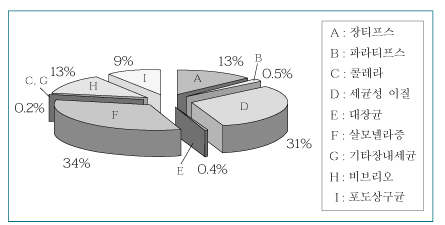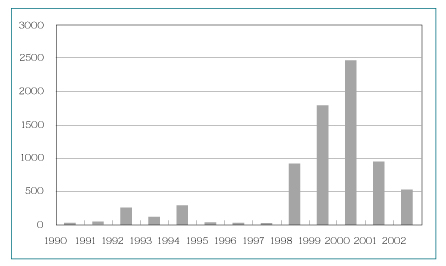J Korean Med Assoc.
2003 Jun;46(6):527-532. 10.5124/jkma.2003.46.6.527.
Bacillary Dysentery
- Affiliations
-
- 1Department of Internal Medicine, Hanyang University College of Medicine & Hospital, Korea. paihj@unitel.co.kr
- KMID: 2183090
- DOI: http://doi.org/10.5124/jkma.2003.46.6.527
Abstract
- Bacillary dysentery is still an important food-borne infection worldwide. Because a small inoculum can establish the infection, contact, food, and water are the usual transmission route. Abdominal pain and diarrhea are the early symptoms, followed by bloody and mucoid stool and tenesmus. Although the diagnosis of shigellosis is based on the stool culture, diarrhea with general symptoms persisting for several days and intrafamilial spread suggest the shigellosis. The high resistance rate against the first-line antimicrobials is a serious social problem in developing countries. In countries showing a high resistance rate of trimethoprim-sulfamethoxazole or ampicillin, including Korea, the treatment choice for shigellosis is fluoroquinolone for 3 days in adults. In Korea, there has been a dramatic increase of shigellosis from 1998. Shigella sonnei is the most common pathogen, and S. flexneri has been isolated continuously in a small number. Analyzing the incidence by age and provinces, the infection occurred most frequently in the age group under twenties, and Cheju, Kyeongnam, Chonnam, and Kangwon show the high incidence rate of shigellosis. Although seasonal variation of shigellosis was influenced by regional outbreaks, the infection occurred most commonly in late spring and early autumn. The resistance rate of trimethoprim-sulfamethoxazole was very high, over 90%, but ampicillin resistance varied widely according to the epidemics or regions. The analyses of several epidemics of shigellosis from 1998 to 2000 indicate that the school lunch program is the most important cause for the recent increase of shigellosis in Korea. The strict regulation of mass food handling is critical for the control of shigellosis.
Keyword
MeSH Terms
-
Abdominal Pain
Adult
Ampicillin
Ampicillin Resistance
Developing Countries
Diagnosis
Diarrhea
Disease Outbreaks
Dysentery, Bacillary*
Food Handling
Gangwon-do
Gyeongsangnam-do
Humans
Incidence
Jeju-do
Jeollanam-do
Korea
Lunch
Seasons
Shigella sonnei
Social Problems
Trimethoprim, Sulfamethoxazole Drug Combination
Ampicillin
Figure
Cited by 1 articles
-
History and Epidemiology of Bacillary Dysentery in Korea: from Korean War to 2017
Hyunjoo Pai
Infect Chemother. 2020;52(1):123-131. doi: 10.3947/ic.2020.52.1.123.
Reference
-
7. Pai H, Lee HJ, Choi EH, Kim J, Jacoby GA. Identification of CTX-M-14 extended-spectrum beta-lactamase in clinical isolates of Shigella sonnei, Escherichia coli, and Kleb-siella pneumoniae in Korea. J Clin Microbiol. 2001. 39(10):3747–3749.
Article8. DuPont HL. Mandell GL, Bennett JE, Dolin R, editors. Shigella species (Bacillary dysentery). Principles and practice of infectious diseases. 1995. 4th ed. Churchill Livingstone Co.;2033–2039.9. Subekti D, Oyofo BA, Tjaniadi P, Corwin AL, Larasati W, Putvi M, et al. Shigella spp Surveillance in Indonesia : the emergence or reemergence of S. dysenteriae. Emerg Infect Dis. 2001. 7:137–134.10. Isenbarger DW, Hoge CW, Srijan AS, Pitarangsi C, Vithayasai N, Bodhidatta L, et al. Comparative antibiotic resistance of diarrheal pathogens from Vietnam and Thailand, 1996-1999. Emerg Infect Dis. 2002. 8:175–180.
Article



